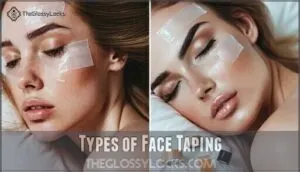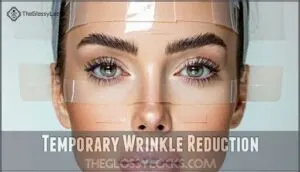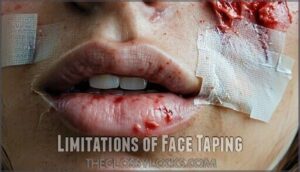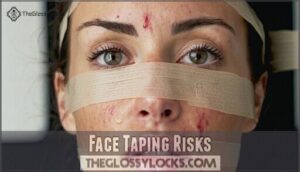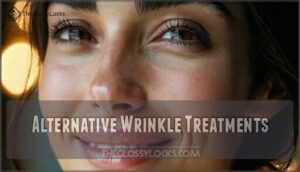This site is supported by our readers. We may earn a commission, at no cost to you, if you purchase through links.
 Face taping for wrinkles works like putting a bandage on fabric – it smooths things out temporarily, but the creases return once you remove it.
Face taping for wrinkles works like putting a bandage on fabric – it smooths things out temporarily, but the creases return once you remove it.
You’ll see immediate lifting and wrinkle reduction while wearing the tape, making it popular for quick photo fixes or special events.
However, dermatologists caution that this trendy hack won’t create lasting anti-aging results.
The tape simply holds your skin in a stretched position, similar to how you might pull back loose skin with your hands.
Regular use can irritate sensitive facial skin or cause allergic reactions.
While face taping offers instant gratification, understanding its limitations and potential risks helps you make smarter skincare choices.
Table Of Contents
- Key Takeaways
- Face Taping Basics
- Face Taping Effectiveness
- Face Taping Risks
- 6 Best Face Tapes for Wrinkles
- Alternative Wrinkle Treatments
- Frequently Asked Questions (FAQs)
- Does taping wrinkles really work?
- Do face strips work for wrinkles?
- What is the best overnight face tape for wrinkles?
- Does taping your face help wrinkles?
- Does facelift tape really work?
- How often should you use face tape?
- What is face taping for wrinkles?
- What are the ways to get rid of wrinkles on the face?
- Can face taping reduce forehead wrinkles?
- How long does it take to see results?
- Conclusion
Key Takeaways
- You’ll see instant wrinkle smoothing while wearing face tape, but the effects vanish completely once you remove it – there’s no lasting anti-aging benefit.
- Face taping can irritate your skin, cause allergic reactions, clog pores, and damage hair follicles, especially with frequent use or aggressive removal.
- You’re essentially getting a temporary mechanical lift that works like pulling your skin back with your hands – it’s purely cosmetic and doesn’t prevent future wrinkles.
- You’ll get better long-term results from proven treatments like Botox, dermal fillers, laser resurfacing, or quality skincare products rather than relying on tape for wrinkle reduction.
Face Taping Basics
Face taping uses specialty adhesive strips to temporarily lift and smooth your skin, creating an instant tightening effect on areas like your forehead, cheeks, and around your eyes.
You’ll find two main approaches: overnight patches that claim to reduce wrinkles while you sleep, and lifting tape that’s anchored to your hairline for events and special occasions.
History of Face Taping
Face taping didn’t start with TikTok beauty trends.
In 1889, Margaret Kroesen created Frownies to help her daughter’s forehead wrinkles.
The technique gained momentum in the 1970s when Dr. Kenzo Kase developed kinesiology tape.
Drag performers and celebrities have long used facial tape for an instant facelift effect, keeping this age-old beauty secret alive.
Types of Face Taping
In the context of face taping wrinkles, you’ve got two main roads to choose from.
The first involves the Celebrity Use String Method with Hairline Anchoring – think red carpet magic where antiwrinkle taping gets blended into your hair for an invisible lift.
The second is Overnight Taping using Medical Tape patches designed for facial smoothing tape applications while you sleep.
Many people are now exploring specialty adhesive options for this purpose, considering specialty adhesive options.
Benefits of Face Taping
Face taping offers several appealing benefits that attract beauty enthusiasts seeking quick fixes.
Here’s what you can realistically expect:
- Instant Facelift effect for photos and special occasions
- Event Enhancement that lifts brows and smooths forehead lines temporarily
- Temporary Lift around cheeks and jawline lasting several hours
- Cosmetic Preview of potential surgical results before committing
- Limited Benefits with wrinkle reduction tape requiring realistic expectations
The benefits of face taping are varied and can provide a range of effects for different needs.
Face Taping Effectiveness
You’re probably wondering if face taping actually works to reduce wrinkles, and the short answer is that it provides temporary results at best.
The tape can smooth your skin and lift certain areas while you’re wearing it, but these effects disappear as soon as you remove the tape, which is why it offers no lasting benefits.
Temporary Wrinkle Reduction
When you peel off that wrinkle reduction tape, reality hits hard.
Face taping offers a fleeting illusion of smoother skin, but it’s basically a Cinderella solution with limited efficacy. That mechanical browlift you see? It vanishes instantly upon removal.
While taping for face wrinkles provides appearance improvement, it’s just a temporary fix—not the anti-aging miracle you’re hoping for. Many users find adhesive face strips useful for short-term results.
| What You See | What Actually Happens |
|---|---|
| Smooth forehead lines | Tape physically holds skin flat |
| Lifted brow area | Mechanical tension creates temporary lift |
| Reduced crow’s feet | Visual camouflage, not skin repair |
Instant Lifting and Smoothing
When you need Immediate Results for a special occasion, face taping delivers a Temporary Facelift effect within minutes.
Here’s what Event Enhancement offers:
- Brow Lift – Tape pulls eyebrows upward for alertness
- Cheek Definition – Creates sharper facial contours
- Skin Lifting – Smooths facial tape lines temporarily
- Quick Fix – Perfect for photos and events
This temporary lift works mechanically, like hoisting a flag.
Limitations of Face Taping
While face taping offers instant results, its limitations are significant.
Temporary results vanish once you remove the tape, providing no prevention of future wrinkles.
Limited effectiveness means you can’t camouflage the tape easily, and irritation potential increases with frequent use.
Side effects include skin irritation, allergic reactions, damaged skin, and acne outbreaks from adhesive buildup.
Face Taping Risks
Before you start taping your face, you should know about the potential side effects that come with this beauty trend.
Face taping can cause skin irritation, allergic reactions, acne breakouts, and even damage to your skin and hair follicles if you’re not careful, which can lead to allergic reactions.
Skin Irritation and Allergic Reactions
Your skin’s reaction to adhesive composition varies wildly.
Some people develop redness, rashes, or full-blown allergic reactions to tape adhesives like acrylates.
Sensitive skin faces higher risks of irritation during tape removal, potentially causing blisters or damaged skin.
Even medical-grade tapes aren’t foolproof.
Long-term effects include accelerated aging from repeated pulling, making blister prevention essential for safe application.
Acne and Clogged Pores
Beyond irritation lies another concern: acne breakouts.
Tape occlusion creates a perfect storm for clogged pores by trapping oil, sweat, and bacteria against your skin barrier.
Overnight face taping worsens this problem, giving bacteria growth ample time to flourish.
Your usual cleansing routines can’t penetrate sealed areas, making pore size appear larger once you remove the tape.
Damaged Skin and Hair Follicles
Aggressive tape removal acts like sandpaper on your face, stripping away the protective stratum corneum layer.
Face taping promises instant results, but your skin pays the price when the tape comes off.
This excessive pulling risks permanent damage that goes beyond surface irritation.
Signs of tape adhesive damage include:
- Follicle stress signs – Red, inflamed bumps around hair roots
- Patchy skin texture from repeated stratum corneum removal
- Stretched skin that doesn’t bounce back after overnight face taping
- Scarring from blisters caused by strong adhesives
- Premature aging from long-term effects of constant pulling
6 Best Face Tapes for Wrinkles
If you’re considering face taping, choosing the right product can make the difference between smooth results and skin irritation.
We’ve reviewed six options that balance effectiveness with gentle adhesion, though remember that results remain temporary regardless of which tape you select, focusing on achieving smooth results.
1. KT Tape Sensitive Skin Beige
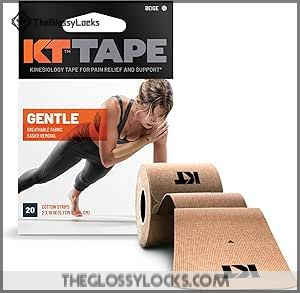
Made from 100% cotton, KT Tape Sensitive Skin offers a gentler approach to face taping.
You’ll find it hypoallergenic and free from latex and natural rubber, making it suitable for delicate facial skin.
The precut 10-inch strips come with rounded corners that won’t catch on clothing or pillows.
While it stays put for 1-3 days, some users report it doesn’t adhere as strongly as regular versions, though it’s reasonably priced and comparable to physical therapy tape, with results that vary between individuals.
Best For: People with sensitive skin looking for a hypoallergenic, gentle option for face taping or muscle and joint support.
- Made from 100% cotton and hypoallergenic materials.
- Precut strips with rounded corners for easy use and less snagging.
- Comfortable fit with a design suitable for sensitive skin.
- May not adhere as well as regular versions.
- Some users report quick peeling or poor durability.
- Potential for skin irritation despite being designed for sensitive skin.
2. Medik8 Crystal Retinal 1 Serum
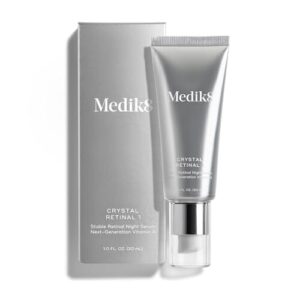
Surprisingly, this isn’t actually a tape at all—it’s a powerful anti-aging serum that works while you sleep.
You’ll get 0.01% retinaldehyde, which delivers results up to 11 times faster than regular retinol.
The formula includes hyaluronic acid and vitamin E to keep your skin hydrated while smoothing fine lines.
Use it every other night and layer with your favorite moisturizer.
Many users report supple, amazing skin after consistent use, though some find the packaging feels cheap for the price point.
Best For: Individuals looking for a gentle yet effective anti-aging serum that hydrates, smooths fine lines, and delivers faster results than traditional retinol.
- Some users find the packaging to feel cheap for the price.
- May cause breakouts for certain individuals.
- Cannot be used with other active ingredients like Vitamin C or exfoliants.
- Contains retinaldehyde, which works up to 11x faster than retinol.
- Hydrates and smooths skin with hyaluronic acid and vitamin E.
- Suitable for all skin types, including sensitive skin.
3. Drunk Elephant Vitamin C Day Serum
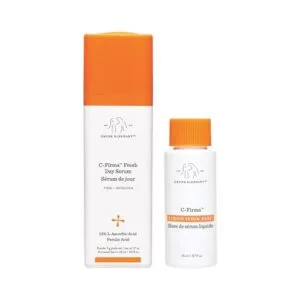
You’ll want to pair face taping with powerful skincare like Drunk Elephant’s Vitamin C Day Serum.
This 15% vitamin C powerhouse firms skin and tackles photoaging while you’re smoothing wrinkles with tape.
The formula combines L-ascorbic acid, ferulic acid, and vitamin E to brighten your complexion and protect against free radicals.
Apply one pump to clean skin before taping for maximum benefits.
Think of it as your skin’s insurance policy – the antioxidants work overtime while the tape handles the heavy lifting, providing a way to protect against free radicals.
Best For: Those looking to brighten, firm, and protect their skin while reducing signs of photoaging.
- Contains 15% vitamin C for potent antioxidant protection.
- Improves skin radiance and evens tone while reducing discoloration.
- Protects against free radicals and supports the skin barrier.
- Requires mixing before first use, which may be inconvenient.
- Potential for skin sensitivity if overused or with improper application.
- Needs to be paired with sunscreen for full UV protection.
4. Method Pink Grapefruit Foaming Hand Soap

This soap clearly doesn’t belong in a face taping roundup, but here’s what you’re getting anyway.
Method’s Pink Grapefruit Foaming Hand Soap comes in recycled plastic bottles and uses plant-based cleansers. It’s free from parabens and phthalates, which is nice for your hands.
The grapefruit scent is invigorating, and the foaming action feels satisfying. However, this product won’t help with wrinkles or face taping needs.
You’d be better off using it for its intended purpose – washing your hands, which is a more practical use.
Best For: Eco-conscious individuals looking for a biodegradable, plant-based foaming hand soap with a refreshing grapefruit scent.
- Scent may be too mild for some users’ preferences.
- Pump mechanism is not made from recycled material.
- Not suitable for face care or other off-label uses.
- Made with biodegradable, plant-based cleansers.
- Bottles are crafted from 100% recycled plastic.
- Free from parabens, phthalates, and cruelty.
5. Method Sea Minerals Gel Hand Soap
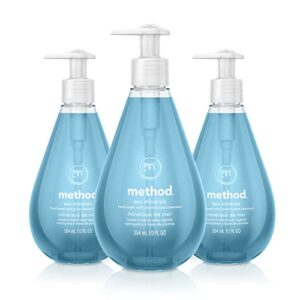
Looking for gentle cleansing that won’t irritate sensitive skin during your face taping routine? This biodegradable gel soap features plant-based cleansers and an invigorating sea minerals scent with bergamot, lemon, and rosemary notes.
You’ll appreciate that it’s paraben-free, phthalate-free, and cruelty-free. The 12-ounce bottles come in eco-friendly packaging made from recycled plastic.
While it leaves hands feeling soft and clean, remember this is hand soap, not face tape. It’s perfect for washing your hands before applying actual face taping products.
Best For: Individuals seeking an eco-friendly, cruelty-free hand soap with a refreshing scent and gentle cleansing formulation.
- Biodegradable formula made with plant-based cleansers.
- Paraben-free, phthalate-free, and cruelty-free composition.
- Eco-friendly packaging made from 100% recycled plastic.
- Designed specifically for hand washing, not suitable for face or body.
- Pump component materials are unspecified regarding recyclability.
- Limited scent options focused on "Sea Minerals.
6. Dove Sensitive Skin Beauty Bar Fragrance-Free
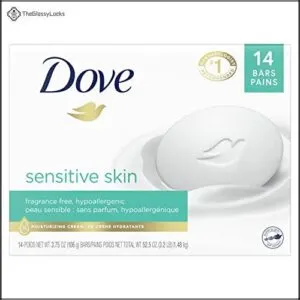
While this fragrance-free beauty bar isn’t technically face tape, this is a relevant point for your pre-taping routine.
You’ll want clean, debris-free skin before applying any adhesive product. This hypoallergenic bar contains ¼ moisturizing cream and won’t strip your skin’s natural barrier like harsh soaps.
Its pH-balanced formula works well for sensitive areas you might tape. However, some users report formula changes causing irritation, so patch-test first.
Remember, proper skin prep makes tape removal gentler and reduces your risk of adverse reactions, which is why it’s crucial for a successful taping experience, ensuring gentler removal.
Best For: Those with sensitive skin who need a gentle, fragrance-free cleansing bar that maintains moisture.
- Fragrance-free and hypoallergenic, ideal for sensitive skin.
- Contains ¼ moisturizing cream, leaving skin soft and nourished.
- PH-balanced to protect the natural moisture barrier.
- Some users report irritation after formula changes.
- Weaker lather compared to older versions.
- May cause dryness in very dry climates.
Alternative Wrinkle Treatments
If you’re looking for longer-lasting wrinkle solutions beyond face tape, several proven treatments can deliver more consistent results.
These medical options work differently than tape by targeting the underlying causes of wrinkles rather than just temporarily smoothing your skin’s surface.
Botox and Neuromodulators
Getting real results requires stepping beyond temporary fixes.
Real beauty transformations demand commitment beyond quick fixes and temporary solutions.
Botox and other neuromodulators like Dysport work by blocking nerve signals to facial muscles, preventing the contractions that create expression lines.
Unlike face taping’s fleeting effects, these neurotoxins deliver consistent wrinkle reduction for three to five months.
Here’s what sets neurotoxins apart:
- Proven mechanism – They temporarily paralyze wrinkle-causing muscles
- Lasting results – Effects continue working 24/7 for months
- Targeted treatment – Precise injection techniques address specific problem areas
Laser Skin Resurfacing
Laser skin resurfacing offers a more permanent solution than face taping for wrinkles and fine lines.
This cosmetic procedure uses different laser types to promote collagen stimulation, improving skin texture over time.
While procedure cost ranges from hundreds to thousands of dollars and treatment downtime varies, expected results include smoother, younger-looking skin that lasts years, not hours, with long-lasting effects.
Dermal Fillers and Chemical Peels
Beyond resurfacing treatments, dermal fillers and chemical peels offer different approaches to wrinkle reduction.
Dermal fillers add volume to deep lines, with filler longevity varying by product type. Chemical peels remove damaged skin layers, with peel depth determining results.
Treatment combinations work well for different skin types, though procedure costs vary substantially based on your chosen cosmetic procedures.
Key considerations for these cosmetic treatments:
- Filler longevity ranges from 6-18 months depending on the specific product and injection site
- Peel depth determines recovery time, with superficial peels requiring minimal downtime versus deep peels
- Skin types respond differently to each treatment, requiring personalized consultation with professionals
- Procedure costs can range from hundreds to thousands of dollars per session for these wrinkle solutions
Combining Face Taping With Other Treatments
You can combine face taping with other cosmetic treatments for enhanced results.
Pairing taping with Botox creates 24/7 muscle relaxation plus instant lifting for events. When used alongside facial massage or gua sha, taping maintains circulation benefits longer.
However, avoid combining with chemical peels during recovery periods to prevent skin irritation. Many people also explore options for face taping botox.
| Treatment Combination | Benefits | Precautions |
|---|---|---|
| Face Taping + Botox | Maximizes wrinkle reduction, instant lift | Monitor for skin sensitivity |
| Face Taping + Massage | Prolonged circulation boost, enhanced lifting | Use gentle pressure only |
| Face Taping + Chemical Peels | Improved skin texture support | Wait for complete healing first |
Frequently Asked Questions (FAQs)
Does taping wrinkles really work?
Like putting makeup on a cracked mirror, taping wrinkles creates temporary smoothing effects that vanish once you remove the tape.
You’ll see slight improvement while it’s on, but don’t expect lasting results.
Do face strips work for wrinkles?
Face strips provide temporary wrinkle smoothing while you’re wearing them, but don’t expect lasting results.
They’re like makeup for your skin – helpful for events, but wrinkles return once you remove the strips.
What is the best overnight face tape for wrinkles?
Shopping for overnight face tape is like hunting for a unicorn—they promise magic but deliver disappointment.
No tape effectively treats wrinkles long-term.
You’ll see temporary smoothing, but experts recommend Botox or proper skincare instead.
Does taping your face help wrinkles?
Taping your face provides only temporary wrinkle smoothing while the tape’s on.
Once you remove it, wrinkles return immediately.
It’s like pressing pause on aging – not actually rewinding the clock permanently.
Does facelift tape really work?
Think of facelift tape as theatrical makeup for your skin.
You’ll get temporary lifting effects that vanish once removed.
It won’t prevent wrinkles or provide lasting results, but it works for special events.
How often should you use face tape?
Experts don’t recommend daily face tape use due to skin irritation risks.
You’ll want to limit application to special occasions only.
Regular use can damage your skin barrier and cause breakouts or allergic reactions.
What is face taping for wrinkles?
Like putting a temporary band-aid on time, face taping uses adhesive strips to lift and smooth your skin.
You’ll apply specialty tape to areas like your forehead and cheeks for an instant, short-lived cosmetic boost.
What are the ways to get rid of wrinkles on the face?
You’ve got several proven options: Botox injections weaken wrinkle-causing muscles for three to five months.
Dermal fillers add volume around your mouth and cheeks.
Laser resurfacing promotes collagen growth for smoother skin.
Can face taping reduce forehead wrinkles?
Face taping can temporarily smooth forehead wrinkles while you’re wearing it, but don’t expect miracles.
The effect vanishes once you remove the tape, and repeated use might irritate your skin or cause breakouts, which could be a significant concern for users.
How long does it take to see results?
You’ll see immediate lifting effects the moment you apply the tape.
However, these results disappear within hours of removal.
There’s no waiting period – it’s instant gratification with zero lasting benefits.
Conclusion
Like putting a temporary bandage on a deeper wound, face taping for wrinkles provides quick fixes without addressing underlying skin aging.
You’ll achieve immediate smoothing effects for photos or events, but don’t expect permanent results.
The technique carries real risks including skin irritation and allergic reactions.
Smart skincare means understanding these limitations, and considering proven alternatives like retinoids, professional treatments, or combining face taping strategically with established anti-aging methods for better long-term skin health outcomes, which is key to achieving long-term skin health.


